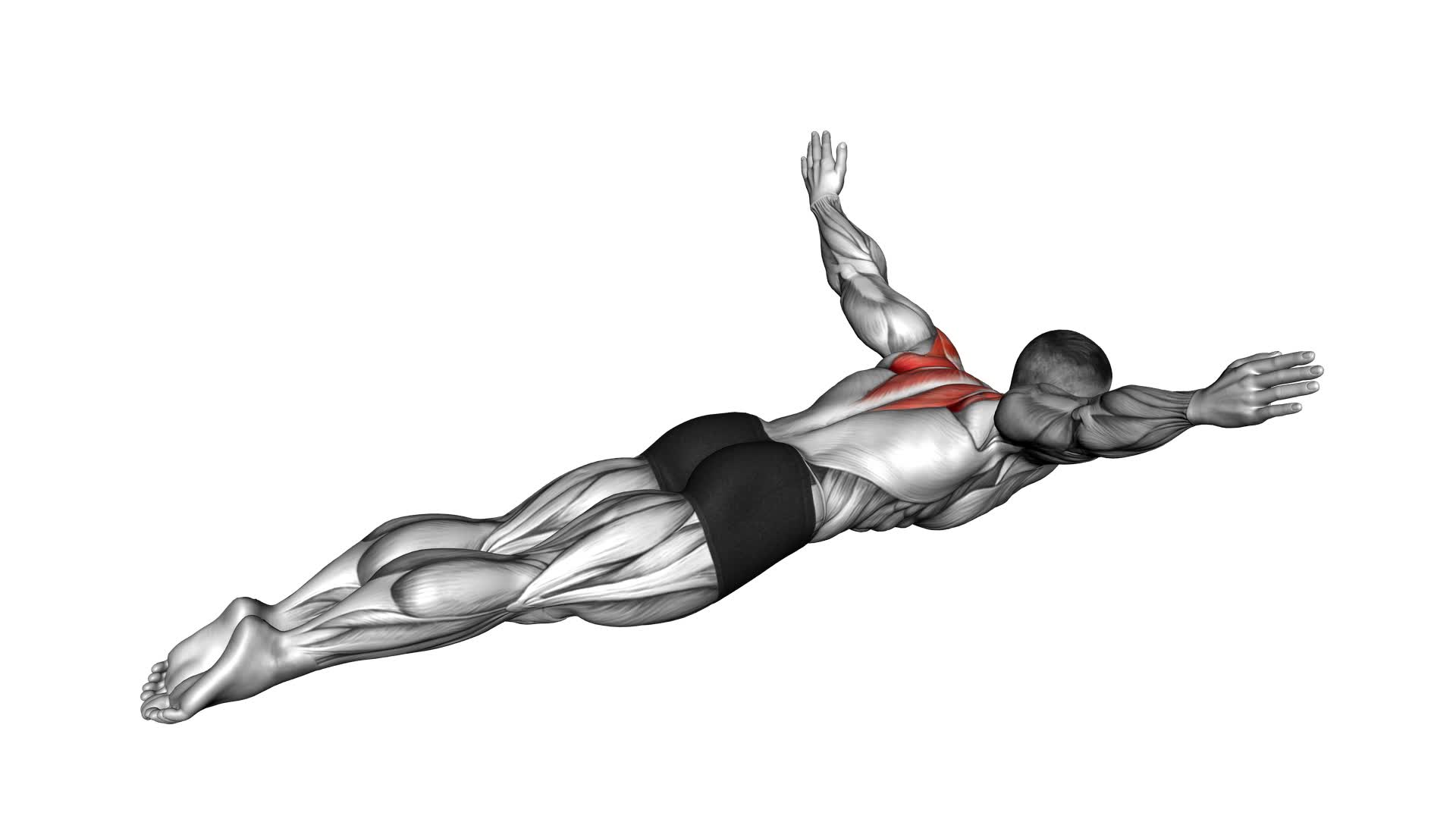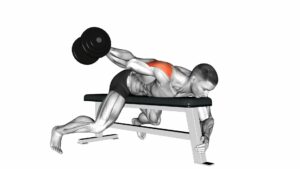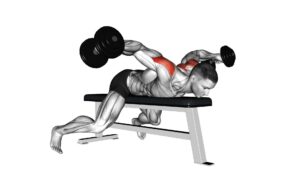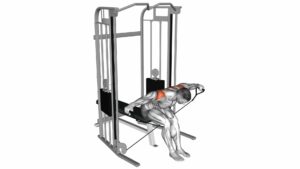Lying Rear Lateral Raise – Video Exercise Guide & Tips

Looking to strengthen your rear deltoids and improve your upper body strength? Look no further than the lying rear lateral raise!
Watch This Exercise Video
In this video exercise guide, we'll show you the proper form and provide some helpful tips to get the most out of this exercise.
Watch and follow along as we guide you step-by-step through the movement. Get ready to feel the burn and see results with this effective shoulder exercise.
Let's get started!
Key Takeaways
- Proper form and technique include lying face down on a flat bench, squeezing shoulder blades together, maintaining a slight bend in the elbows, and keeping the core engaged and a neutral spine.
- Equipment needed for lying rear lateral raises includes a flat bench and dumbbells, with variations including bent-over rear lateral raises and cable rear lateral raises.
- The target muscles for this exercise are the posterior deltoids, trapezius, rhomboids, and infraspinatus.
- To maximize the benefits of lying rear lateral raises, incorporate variations, include the exercise in a full-body workout routine, start with challenging weight and gradually increase, and pair it with exercises targeting other muscle groups.
Proper Form for Lying Rear Lateral Raise
To perform the lying rear lateral raise correctly, lie face down on a flat bench with a dumbbell in each hand. This exercise primarily targets the posterior deltoids, which are the muscles located at the back of your shoulders. The lying rear lateral raise is an effective way to isolate and strengthen these muscles.
As you lift the dumbbells away from your body, focus on squeezing your shoulder blades together to activate the posterior deltoids even more. It's important to maintain a slight bend in your elbows throughout the movement to prevent strain on your joints.
There are a few variations of the lying rear lateral raise that you can try to add variety to your workout routine. One variation is the bent-over rear lateral raise, where you bend over at the waist instead of lying face down on a bench. Another variation is the cable rear lateral raise, which utilizes a cable machine instead of dumbbells. Both of these variations provide a different angle of resistance and can further engage your posterior deltoids.
Now that you understand the proper form and muscle activation during the lying rear lateral raise, let's move on to the equipment needed for this exercise.
Equipment Needed for Lying Rear Lateral Raise
To perform the lying rear lateral raise, you'll need a flat bench and a dumbbell in each hand. The flat bench provides a stable surface for you to lie on during the exercise, while the dumbbells add resistance to target the muscles effectively.
During the lying rear lateral raise, the primary muscles worked are the posterior deltoids, which are located at the back of your shoulders. These muscles play a crucial role in shoulder abduction and stabilization. Additionally, the exercise also engages the trapezius, rhomboids, and infraspinatus muscles, which assist in shoulder movement and posture.
To add variation to the lying rear lateral raise, you can try different grip positions. For example, you can perform the exercise with a neutral grip, palms facing each other, or with a pronated grip, palms facing down. These variations can target slightly different areas of the shoulder muscles and provide a new challenge to your workout routine.
Remember to choose dumbbells that challenge you but still allow you to maintain proper form throughout the exercise. It's essential to start with a weight that you can comfortably handle and gradually increase the resistance as you become stronger.
Step-by-Step Guide to Performing Lying Rear Lateral Raise
Now let's break down how to properly perform the lying rear lateral raise exercise. This exercise targets the muscles in your shoulders and upper back, helping to improve posture and strengthen the deltoids. Here is a step-by-step guide to performing the lying rear lateral raise:
- Lie face down on a flat bench with your chest and abdomen resting against it. Hold a dumbbell in each hand, palms facing each other, and let your arms hang straight down.
- Slowly raise your arms out to the sides, keeping a slight bend in your elbows. Focus on squeezing your shoulder blades together as you lift.
- Continue raising your arms until they're parallel to the floor. Hold for a brief pause at the top of the movement, feeling the contraction in your rear deltoids.
- Slowly lower the dumbbells back to the starting position, maintaining control throughout the movement.
Alternative variations of the lying rear lateral raise include using a resistance band instead of dumbbells or performing the exercise on an incline bench.
Remember to start with lighter weights and gradually increase as you become more comfortable with the movement. Keep your core engaged and maintain proper form to get the most out of this exercise.
Tips for Maximizing the Benefits of Lying Rear Lateral Raise
Maximize the benefits of the lying rear lateral raise by incorporating proper form and gradually increasing the weight used. To ensure you get the most out of this exercise, there are a few tips to keep in mind.
Firstly, consider incorporating effective variations for the lying rear lateral raise. One variation is to use resistance bands instead of dumbbells. This can provide a different type of resistance and target your muscles in a slightly different way. Another variation is to perform the exercise on an incline bench. This will increase the difficulty and engage your muscles even more.
Additionally, it's important to incorporate the lying rear lateral raise into a full body workout routine. This exercise primarily targets your rear deltoids, but it also engages other muscles such as your traps and upper back. To ensure a balanced workout, pair the lying rear lateral raise with exercises that target other muscle groups, such as chest presses, bicep curls, or leg presses.
Remember to start with a weight that challenges you but allows you to maintain proper form. Gradually increase the weight as you become more comfortable and stronger.
Common Mistakes to Avoid During Lying Rear Lateral Raise
Avoid these common mistakes to get the most out of your lying rear lateral raise exercise. By being mindful of these errors, you can prevent injury and ensure proper form throughout your workout.
Here are four common mistakes to avoid during the lying rear lateral raise:
- Using excessive weight: One of the most common mistakes is using weights that are too heavy. This not only compromises your form but also increases the risk of injury. Start with lighter weights and gradually increase the resistance as you become more comfortable and confident with the exercise.
- Raising the arms too high: It's important to avoid raising your arms too high during the exercise. When the arms go above shoulder level, it can put unnecessary strain on the shoulder joint. Instead, focus on lifting your arms to a comfortable height where you can still feel the targeted muscles working.
- Arching the back: Another mistake to avoid is arching your back during the exercise. This not only takes the emphasis away from the targeted muscles but can also strain the lower back. Keep your core engaged and maintain a neutral spine throughout the movement.
- Neglecting alternative exercises: While the lying rear lateral raise is a great exercise, it's important to incorporate other exercises that target the same muscles to avoid overuse and imbalances. Consider adding exercises like bent-over lateral raises or cable lateral raises to your routine.
Frequently Asked Questions
How Many Sets and Reps Should I Do for the Lying Rear Lateral Raise?
For the lying rear lateral raise, you should aim for 3 sets of 10-12 reps.
This exercise targets your rear deltoids, helping to strengthen and tone your upper back and shoulders.
To perform it properly, lie face down on a bench, hold dumbbells in each hand, and raise your arms out to the sides, keeping a slight bend in your elbows.
This variation is great for improving posture and overall upper body strength.
Can I Perform the Lying Rear Lateral Raise With Dumbbells Instead of a Cable Machine?
Yes, you can perform the lying rear lateral raise with dumbbells instead of a cable machine. The dumbbell variation of this exercise allows for a similar range of motion and targets the same muscles.
However, using a cable machine offers additional benefits such as constant tension throughout the movement and the ability to adjust the weight more precisely.
Both options are effective, so choose the one that best suits your preferences and equipment availability.
Is It Necessary to Warm up Before Doing the Lying Rear Lateral Raise?
Before performing the lying rear lateral raise, it's important to warm up. Warming up helps increase blood flow to your muscles, making them more flexible and less prone to injury. It also prepares your body for the upcoming exercise. Skipping the warm-up can lead to strained muscles or other injuries.
Additionally, be cautious of common mistakes like using too much weight or swinging your body to lift the dumbbells. Focus on proper form and control for optimal results.
Can I Incorporate the Lying Rear Lateral Raise Into My Full-Body Workout Routine?
Yes, you can definitely incorporate the lying rear lateral raise into your full-body workout routine.
It's a great exercise for targeting your rear deltoids and upper back muscles.
To add variation to your routine, you can try different grips or use dumbbells instead of a barbell.
Just make sure to maintain proper form and start with lighter weights to avoid injury.
Including this exercise will help you achieve a well-rounded and balanced workout.
Are There Any Alternative Exercises That Target the Same Muscles as the Lying Rear Lateral Raise?
If you're looking for alternative exercises that target the same muscles as the lying rear lateral raise, there are a few options you can consider.
Some exercises that activate similar muscle groups include bent-over lateral raises, standing rear lateral raises, and cable rear delt flyes.
These exercises can help you strengthen and tone your rear deltoids, traps, and upper back.
Incorporating these alternatives into your workout routine can provide variety and help you achieve your fitness goals.
Conclusion
In conclusion, the lying rear lateral raise is an effective exercise for targeting and strengthening the rear deltoids. By following proper form, using the necessary equipment, and following the step-by-step guide, you can maximize the benefits of this exercise.
Remember to avoid common mistakes and incorporate these tips to ensure a safe and effective workout.
Incorporating the lying rear lateral raise into your routine can help improve shoulder strength and stability.

Author
Years ago, the spark of my life’s passion ignited in my mind the moment I stepped into the local gym for the first time. The inaugural bead of perspiration, the initial endeavor, the very first surge of endorphins, and a sense of pride that washed over me post-workout marked the beginning of my deep-seated interest in strength sports, fitness, and sports nutrition. This very curiosity blossomed rapidly into a profound fascination, propelling me to earn a Master’s degree in Physical Education from the Academy of Physical Education in Krakow, followed by a Sports Manager diploma from the Jagiellonian University. My journey of growth led me to gain more specialized qualifications, such as being a certified personal trainer with a focus on sports dietetics, a lifeguard, and an instructor for wellness and corrective gymnastics. Theoretical knowledge paired seamlessly with practical experience, reinforcing my belief that the transformation of individuals under my guidance was also a reflection of my personal growth. This belief holds true even today. Each day, I strive to push the boundaries and explore new realms. These realms gently elevate me to greater heights. The unique combination of passion for my field and the continuous quest for growth fuels my drive to break new ground.







